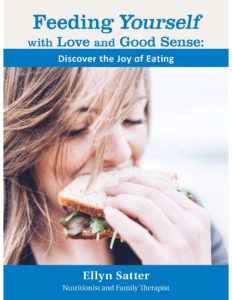

Family Meals Focus
The Ellyn Satter Institute Newsletter
Counseling with the Satter Eating Competence Model (ecSatter)
by Ellyn Satter, MS, MSSW, Dietitian and Family Therapist
For a PDF of this newsletter, click here.
People come into counseling or class expecting advice about what to eat and how to get themselves to eat it. Even though they are caught in the rules, what they really want is to eat enough of food they enjoy and to share rewarding eating times with others.1 How do you refocus the discussion onto Eating Competence so they replace eating negativity with joy, delight, and peace? Professionals who embrace ecSatter have changed their thinking and practice, but the public is still caught in the nutritional black-and-white thinking of the past 50 years.
Learning Eating Competence is experiential
Conventional nutrition education is head learning: what to eat, correct portion sizes, prepare it this way. Because ecSatter is a biopsychosocial model, becoming Eating Competent is a corrective experience. Focus from the beginning on the experience of eating. The Satter Eating Competence Inventory (ecSI 2.0)2 supports that focus. Of the 16 items in ecSI 2.0, only one addresses food selection, and then obliquely: “I consider what is good for me when I eat.” Begin by asking eating-focused questions:
Ask eating-focused questions: How do you see to it you get fed? How do you feel about the way you eat? What would you like to be different?
- How do you see to it that you get fed? This emphasizes the bottom line of Eating Competence: being reliable about feeding themselves.
- How do you feel about eating that way? For instance, does your grazing and eating in a hit-or-miss fashion work for you?
- What would you like to be different? Don’t settle for food selection answers. Keep asking until you get Eating Competence answers: feeling better about food and weight, being less picky, not being so troubled about how much to eat or how much to weigh, having more enjoyable family meals.
Coming out of this general discussion, continue to focus the discussion on eating attitudes and behaviors rather than on food selection. Do they have regular meals? Do they plan for feeding themselves? Are they comfortable with their enjoyment of food and eating? Are they interested in new food, and can they experiment with it? Do they trust themselves to eat enough for them?
Consider capabilities—or gaps
The individual might already do well with eating: They feed themselves reliably, enjoy eating and seek out new food, are tuned in to their hunger, appetite and satiety, and let their body weigh what it wants to weigh. It could be they just need to get out from under their self-criticism: They “should” have more home-cooked meals, eat more vegetables, fewer sweets, or make fewer fast-food jaunts. Your job is to get the “shoulds” out. Nutritionitsas—those who devotedly follow the nutrition rules—are the most challenging. (Yes, I just made up that word. Do you like it?) They are low in EC and unlikely to consider change until their nutritional overzealousness causes pain, often to their children and other family members.
Getting the meal habit stimulates change
Most change can revolve around building enjoyable and rewarding family meals. You might help the unstructured eater or family get the meal habit by putting together meals made up of what they currently eat. You might encourage the nutritionist to tone down their nutritional preoccupation, and they might even listen. Deepen your understanding of ecSatter so you can address issues related to eating attitudes and behaviors as they emerge.3 Learn from the people you teach. Once they get a taste of the joy and reward of pairing feeding themselves faithfully with giving themselves permission to eat,4 they will be creative.
Some have established eating problems
Most eating problems can be addressed with brief intervention: essentially, doing Eating- Competence-focused counseling and nutrition education.5 The person gets it, they make progress on their own, they do some background reading—or not—they come back—or not. If you see them again, you do a bit of encouraging and/or tuning up focusing on eating attitudes and behaviors. Only offer food selection advice if they ask for it. As described in the Satter Hierarchy of Food Needs, their dietary variety and nutritional quality will grow by itself as they gain Eating Competence.6
Some eating problems are so complex and longstanding that they can’t be addressed with brief intervention. In fact, Eating-Competence-focused counseling and nutrition education are likely to be taken out of context and do more harm than good. For most people with such entrenched distortions in eating attitudes and behaviors, the ecSI 2.0 score is particularly low. Typically, their established issues relate to the subcategories of ecSatter: They have conflicted and negative eating attitudes and behaviors, are seriously rigid about what they eat, are chronically restrained eaters who strive for a particular body weight, and provide themselves with regular and reliable meals only when they are actively “on a diet.” Such established issues require secondary intervention as in the “How to Eat” method, taught in the Treating the Dieting Casualty VISION workshop.7
Addressing eating attitudes and behaviors takes relearning
You may feel, as one of my colleagues did when she was struggling to master counseling with Eating Competence, “sometimes I would just like to tell them what to eat.” Therein lies a clue: With EC, you do not tell people what and how much to eat. This may leave you floundering at first, but once you gain an appetite, so to speak, for the humanity and dignity of working with Eating Competence, you won’t want to go back. Keep in mind that for many people, your blessings are enough. In social work school, I learned to make strategic use of myself in helping my patients. You do the same with your own joy, delight, and peace with eating and your desire for your students to experience the same.
References
- Satter EM. Appendix c: What surveys say about our eating. Secrets of feeding a healthy family: How to eat, how to raise good eaters, how to cook. Kelcy Press; 2008:231-234.
- Krall JS, Lohse B. Validation of a measure of the satter eating competence model with low-income females. Int J Behav Nutr Phys Act. Apr 07 2011;8:26-36.
- Satter E. Eating competence: Definition and evidence for the satter eating competence model. J Nutr Educ Behav. 2007;39:S142-S153.
- Satter E. The joy of eating: Being a competent eater. Accessed April 27, 2021. https://www.ellynsatterinstitute.org/wp-content/uploads/2021/04/Joy-of-eating.pdf
- Satter E. Nutrition education with the satter eating competence model. J Nutr Educ Behav. 2007;39 (suppl):S189-S194.
- Satter E. Hierarchy of food needs. J Nutr Educ Behav. 2007;39 (5 suppl):S187-188.
- Satter E. Treating the Dieting Casualty VISION Workshop: Intensive Training on Treating the Chronic Dieter. Ellyn Satter Institute. 2023. https://www.ellynsatterinstitute.org/education/workshops-keynotes/treating-the-dieting-casualty-vision-workshop/
Explore
Continuing education exam for the Satter Eating Competence Model: (ecSatter)
- Clearly understand the evidence for ecSatter, its elaboration in the Hierarchy of Food Needs, and application of ecSatter to nutrition education.
- Examine the validation process for the Satter Eating Competence Inventory, ecSI 2.0,TM and what it says about the nature of Eating Competence.
- Understand how to teach Eating Competence. Differentiate between cognitive and experiential education in teaching/acquiring Eating Competence.


